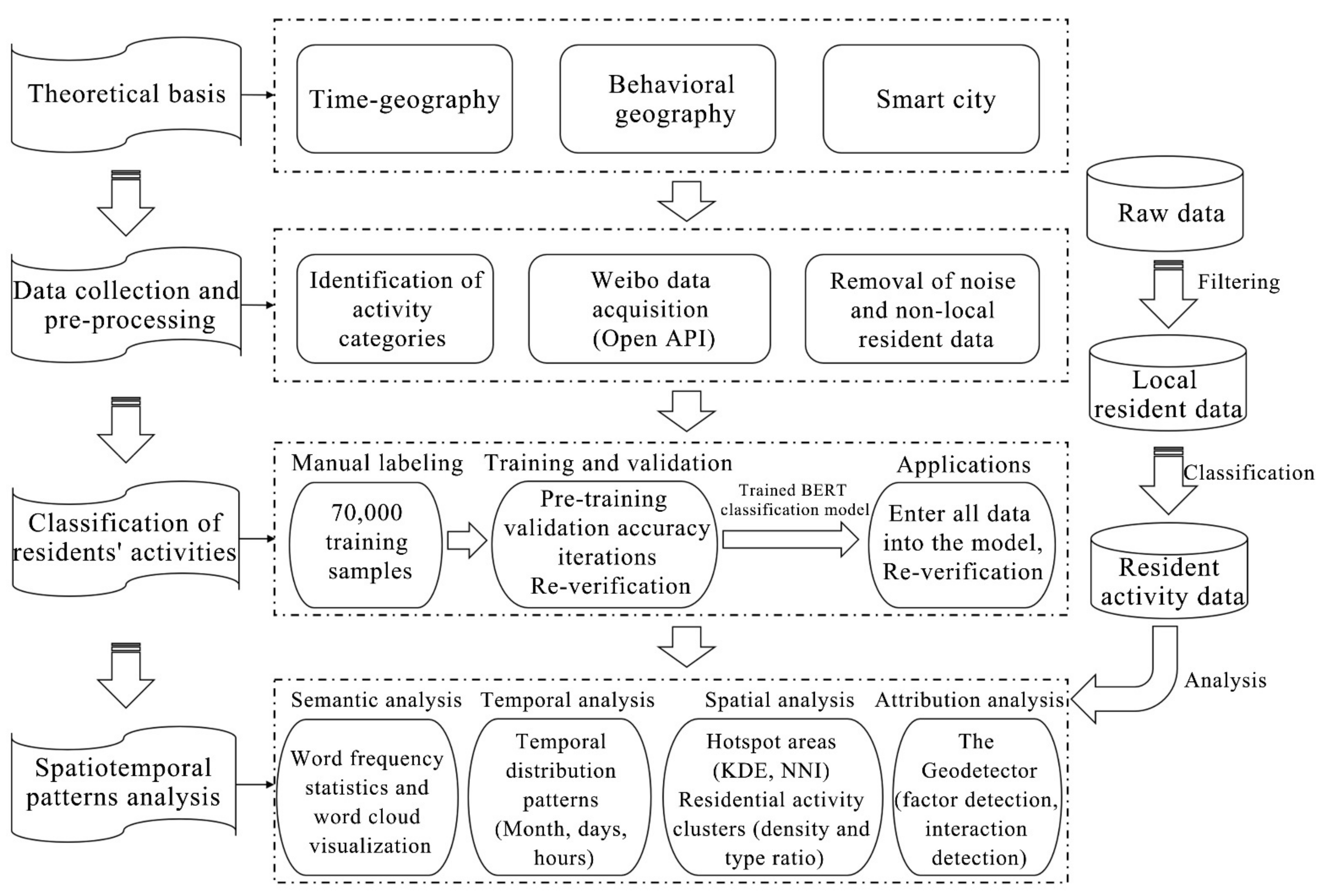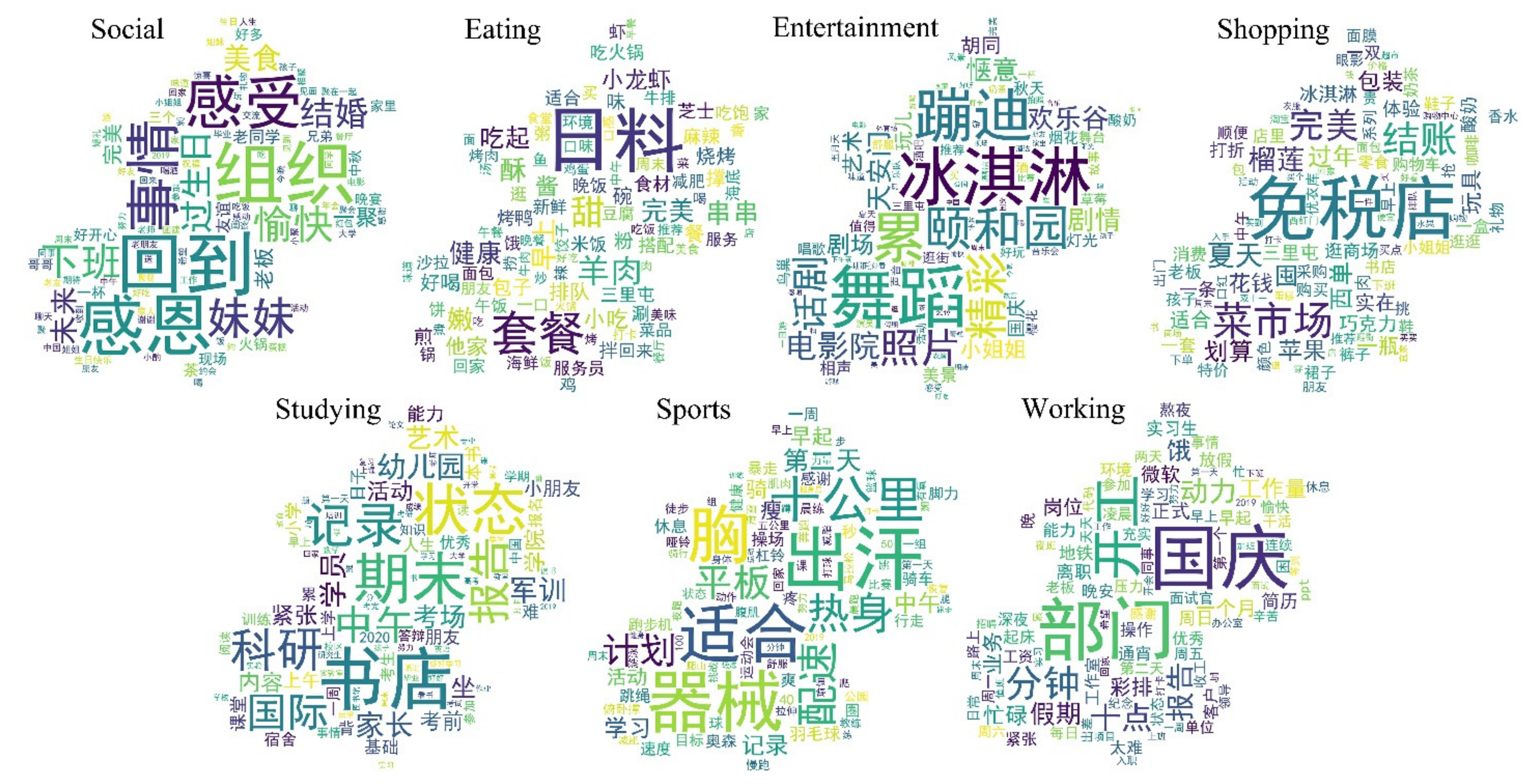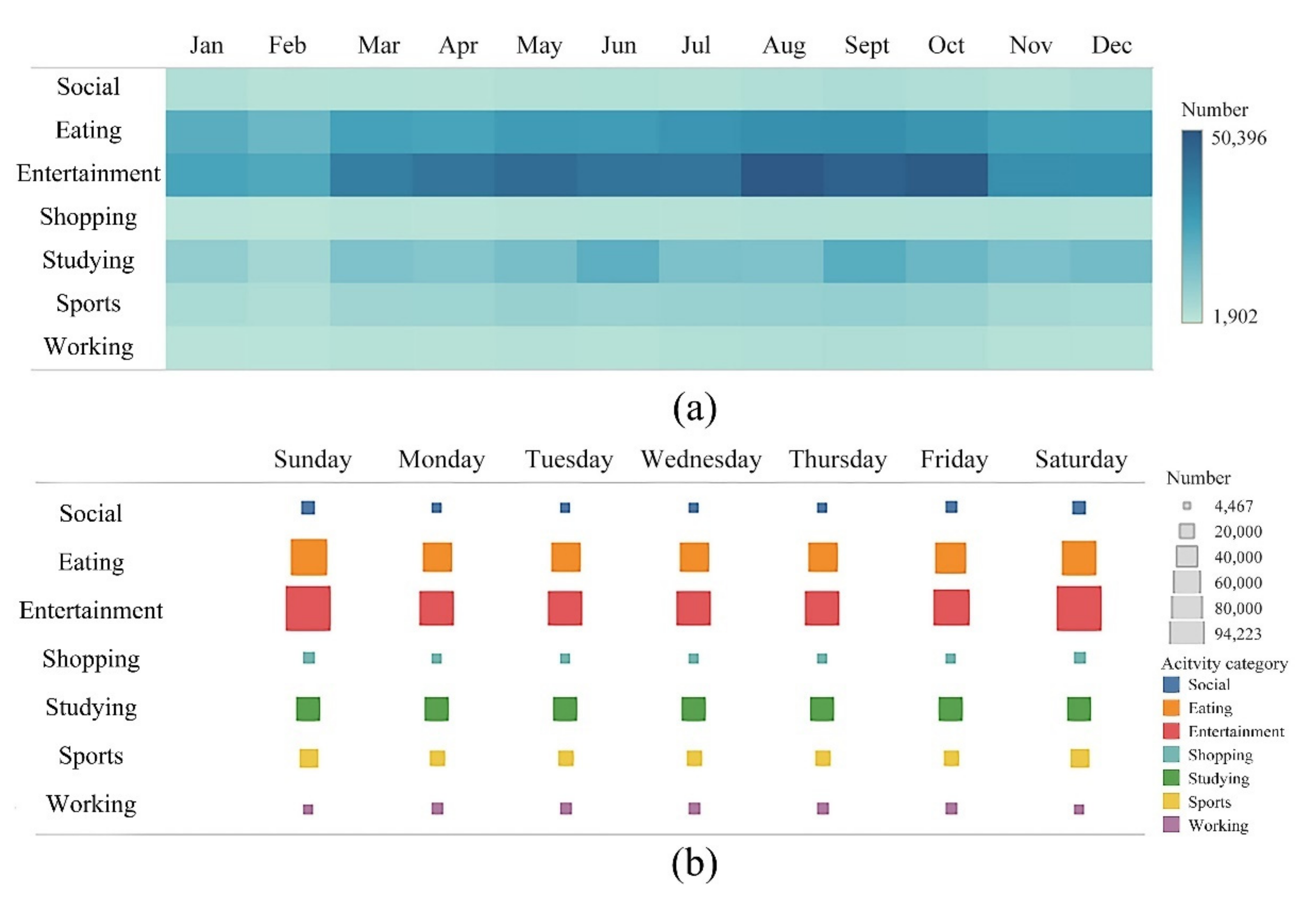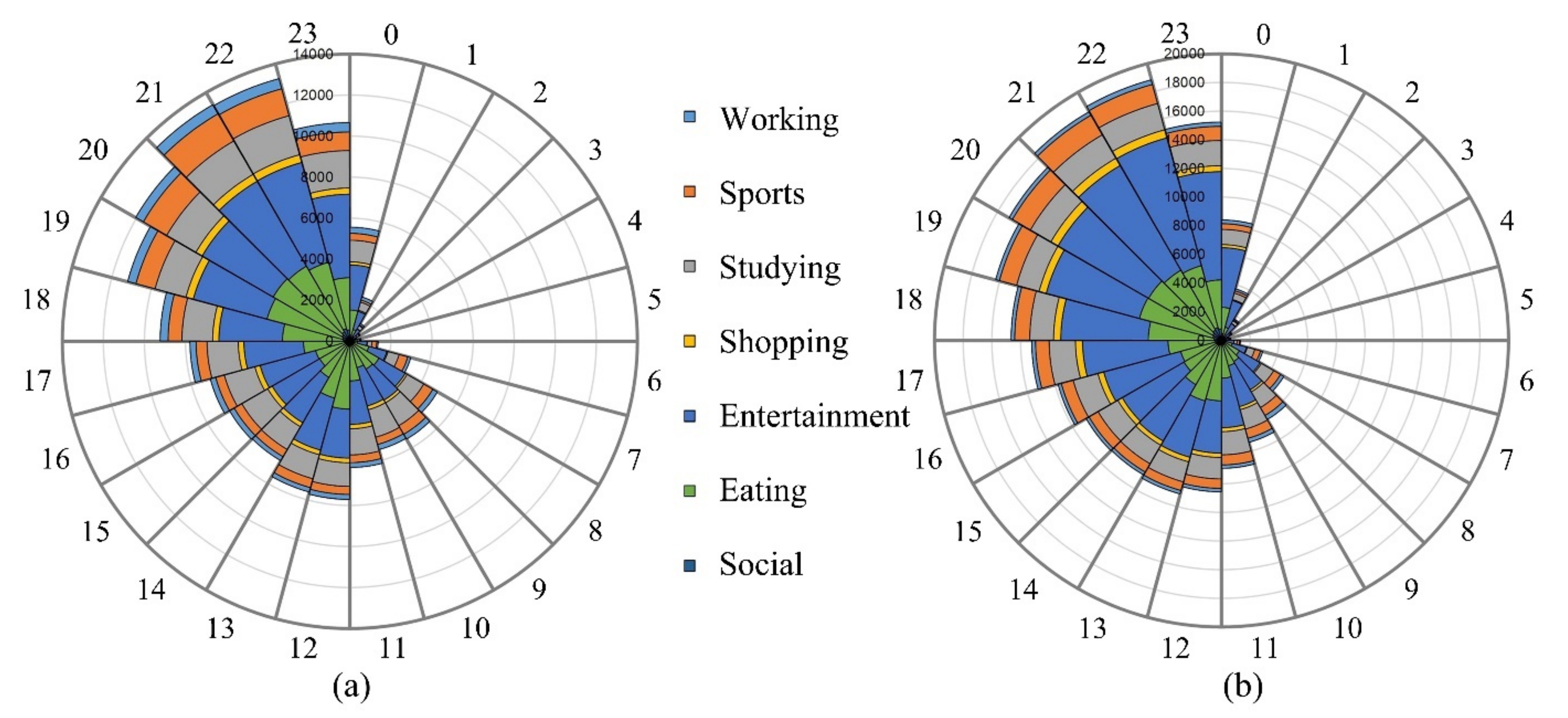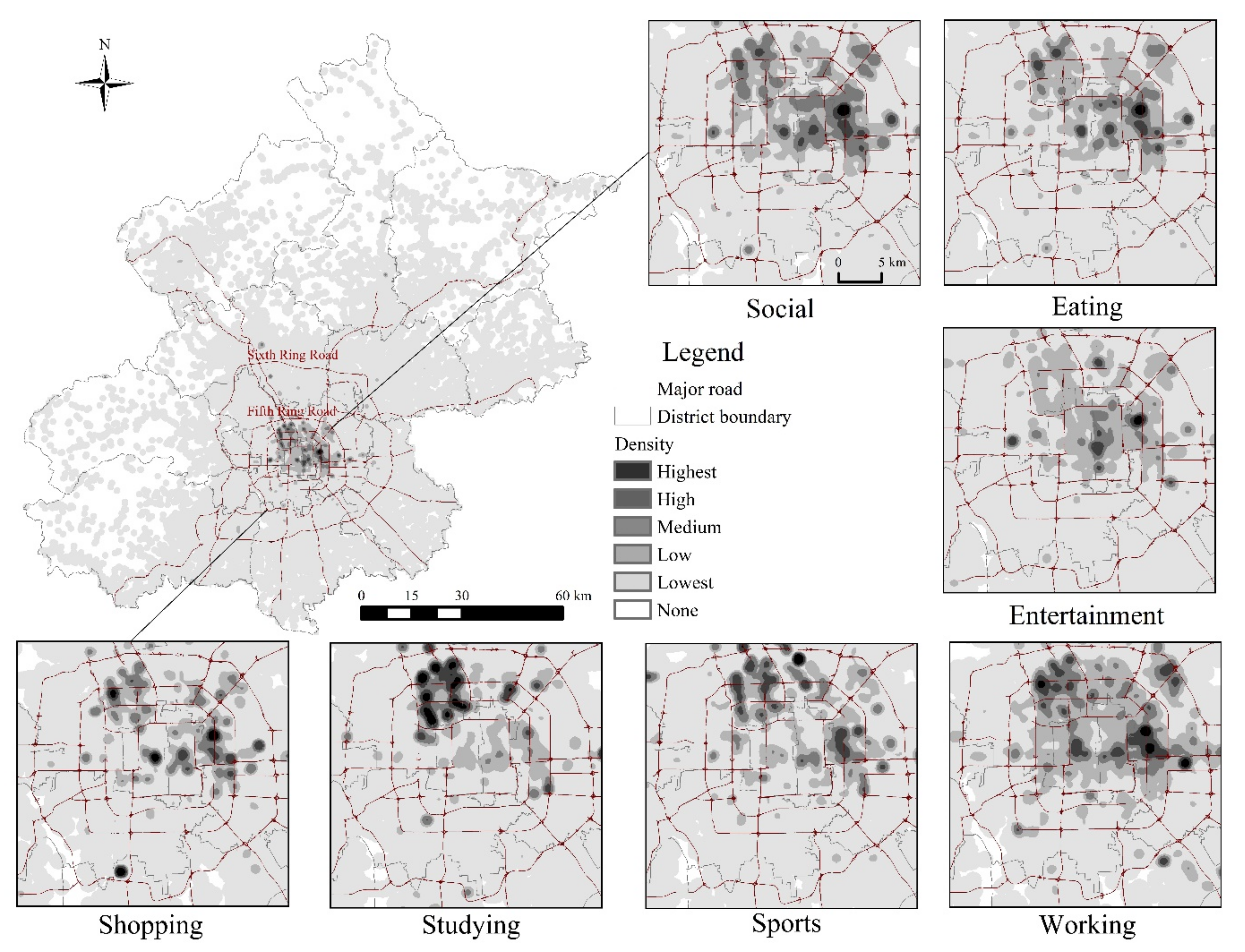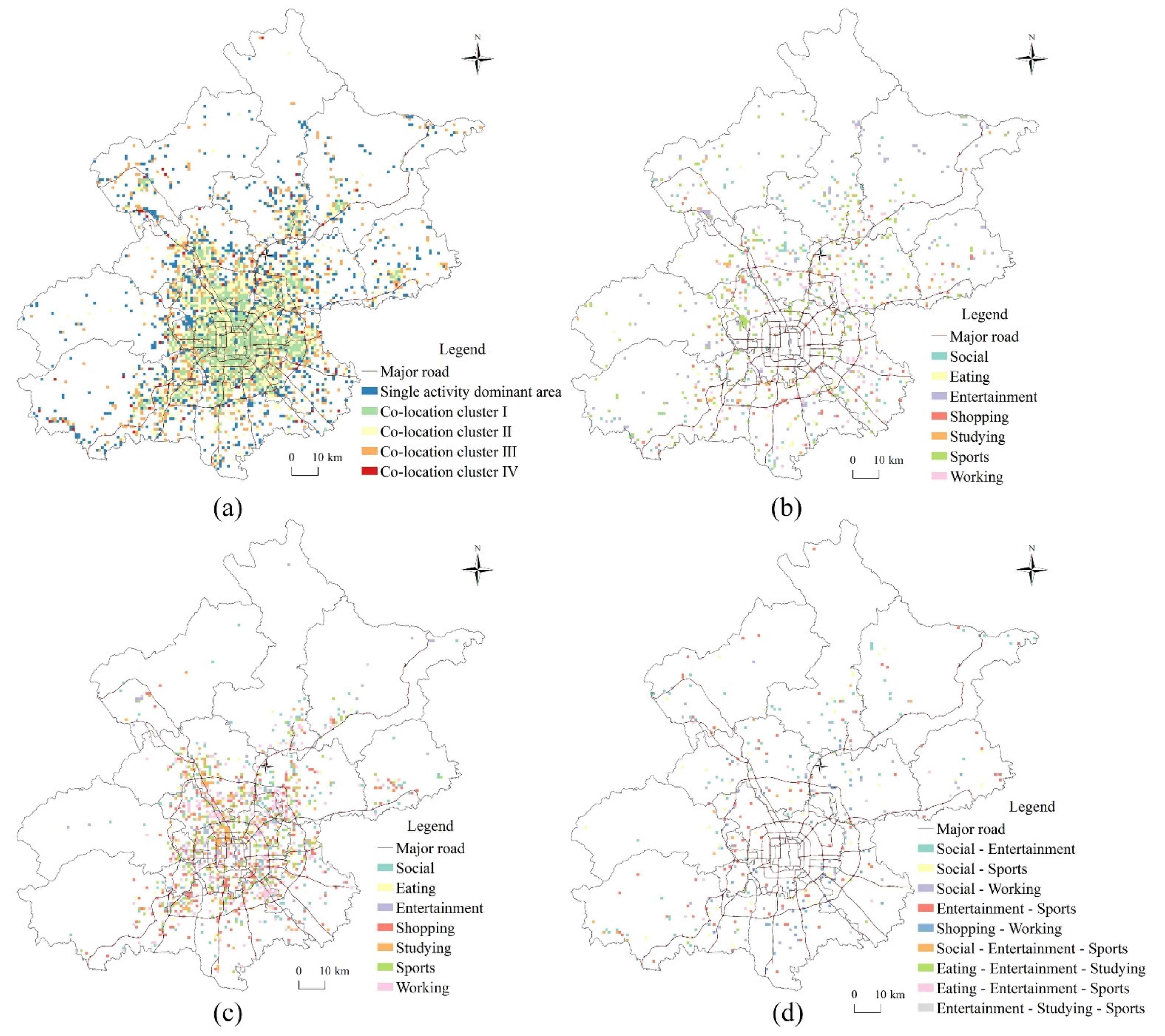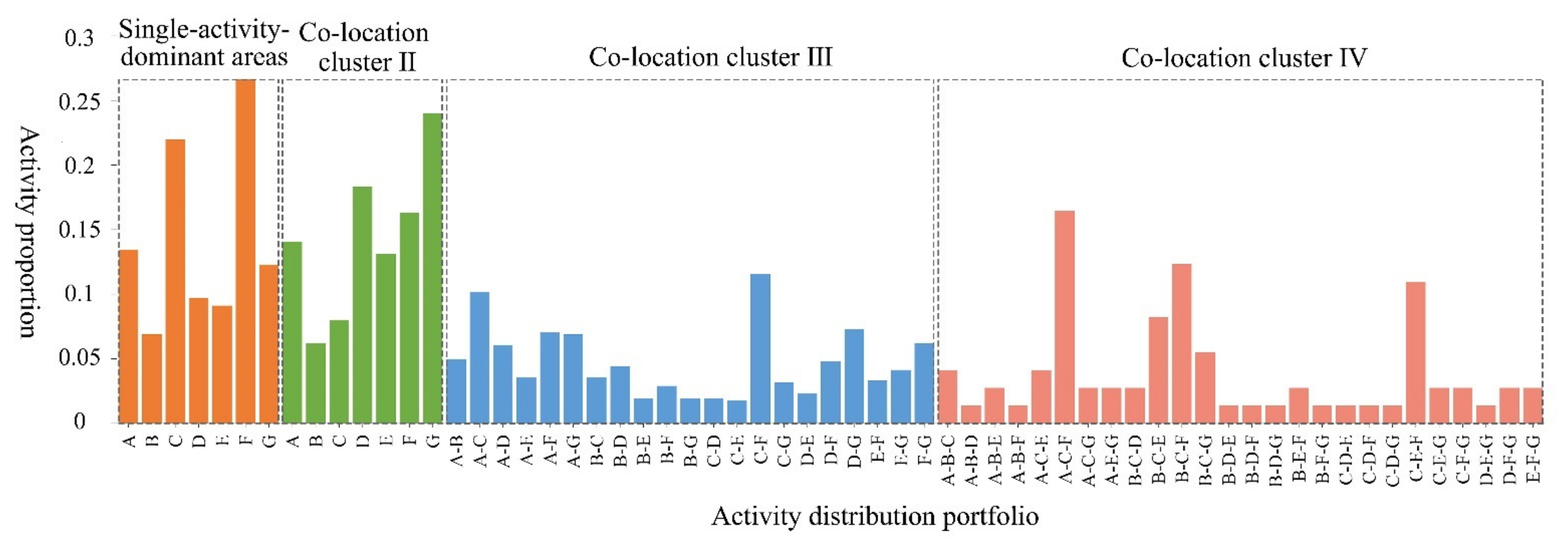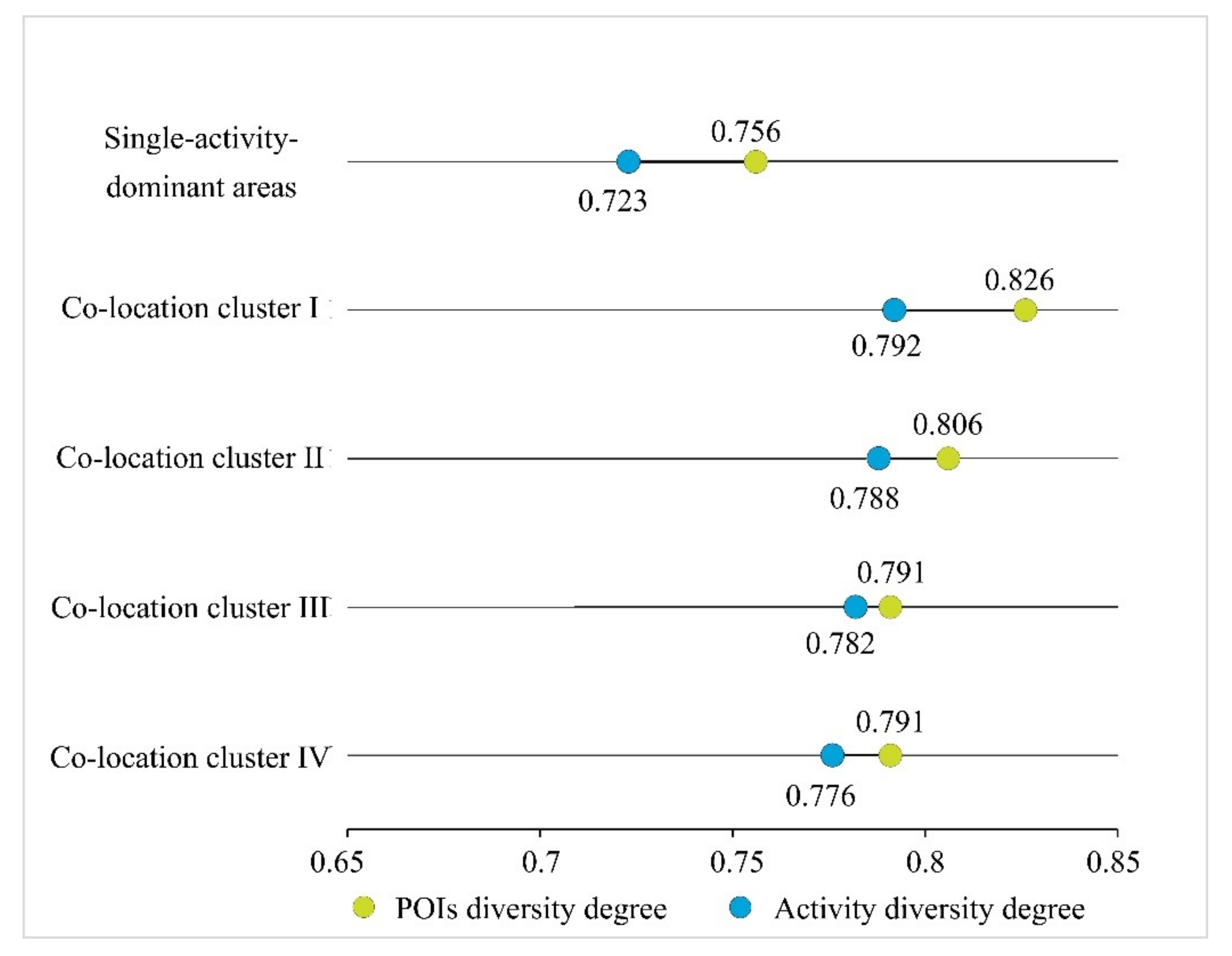1. Introduction
The continuous advancements of globalization and informatization have profoundly affected people’s daily lives and behavioral activities, causing tremendous changes in the traditional patterns of residents’ activities. On the one hand, the emergence of network activities has had numerous effects, including the substitution, complementarity, and enhancement of residents’ daily activities [
1], thereby affecting the use of urban physical space. On the other hand, the rapid development of information and communication technologies (ICTs) has changed the temporal and spatial relationships of residents’ daily activities so that some activities are no longer subject to specific temporal and spatial constraints, thereby allowing better flexibility and coordination [
2]. In this context, research into residents’ activities has received extensive attention in many disciplines, such as geography, urban planning, transportation, computers, and public health [
3,
4,
5]. By exploring the differences in the distribution scales and types of various resident activities, the urban function and spatial structure can be better understood, the temporal and spatial laws of urban dynamics can be grasped, and the relationships between residents’ activities and the objective environment in different temporal and spatial scenarios can be effectively revealed. This is of great significance for improving human health, guiding transportation and planning, and promoting the scientific understanding of human behavior [
6,
7,
8,
9].
With the rapid development of ICTs, while people are enjoying the convenience of ICTs, there has been an explosion of information on user activities and access records, either actively posted by users or passively recorded by devices and networks. It provides a wealth of convenient data to support research into human activities, and thus the exploration of new knowledge and methods of human activity patterns [
10,
11,
12]. Some scholars have suggested that a new field is emerging that can utilize the capacity to collect and analyze data at a certain scale to reveal patterns of individual and group behavior [
13], with sensible data mining algorithms making practical movement predictions that reveal trends and patterns that are difficult for humans to detect [
14]. In this context, there has been tremendous progress in conducting resident activity research based on various types of big data, with an increasing variety of research results. However, the understanding of the interactions between residents’ behavioral decisions and activity dynamics based on general big data (GPS data, mobile phone data, smart card data, inter-floating data, etc.) is limited due to the lack of information on the destinations that instigate population movements [
15].
Fortunately, this limitation does not exist for text-based social media data based on user-initiated posts. Generally speaking, social media data contain detailed spatiotemporal, textual, image, social, and other multidimensional information about the user. It can be used to infer the user’s activities and deeply study the characteristics of residents’ activities and the influence mechanism of their choice of activities. However, among the existing studies on residents’ activities via the use of social media data, most have primarily focused on using the spatial information in social media data, but less on the textual semantic information that contains rich activity content [
16]. Specifically, the textual semantic information not only directly reflects the purpose and type of individual activities at a fine-grained level; furthermore, the quantity of data can also indicate the intensity of an individual’s activity, and, combined with the spatial location, can efficiently reveal the behavioral activity characteristics of individual users [
17]. Therefore, social media data (especially textual information) deserves more attention in the field of resident activity research. Meanwhile, it is necessary to organically combine spatiotemporal information with semantic information to improve the comprehensive utilization efficiency of social media data, and then to comprehensively and truly uncover the spatiotemporal characteristics of the users’ activities and enhance the understanding of the dynamic characteristics of cities and residents.
In view of this, this study aims to introduce the current advanced natural language processing (NLP) technology into the field of resident activity research in order to efficiently extract the rich semantic information from the social media data. Then, the textual semantic information is combined with spatiotemporal information to improve the efficiency of social media data utilization in residential activity research, thus providing a high-quality data base for residential activity research. On this basis, the spatiotemporal characteristics and related patterns of residents’ daily activities were explored, and the driving forces were then investigated to better examine and analyze the spatial structure of the city.
The remainder of this paper is organized as follows. In
Section 2, existing research related to resident activities is presented from three perspectives. In
Section 3, the study area and data collection method are presented. In
Section 4, the process of classifying the residents’ daily activities information is introduced, and the main methods used in this study are elaborated. In
Section 5, the semantic characteristics, spatiotemporal patterns and attribution results of various residents’ activities are specifically analyzed. Finally, the conclusions of this paper are drawn and future research directions are proposed in
Section 6.
6. Discussion and Conclusions
User-initiated social media data, based on a social network platform, contain a wealth of information on resident behavior dynamics, which is of great significance for the understanding of the spatiotemporal patterns and dynamic laws of resident activities in the information age [
60]. Nevertheless, existing related research remains limited in terms of mining the resident activity information in the social media data, while various spatiotemporal clustering methods and their variants are usually used to cluster digital footprints from social media platforms, and while keyword extraction or topic model clustering is performed to identify various resident daily activities. Most of these methods only consider the location information of resident activity while ignoring the geographic background, which leads to certain problems in the identification of activity types [
48]. In this regard, some scholars have pointed out that social media big data contain not only spatial information (e.g., locations, place names, etc.), but, more importantly, rich contextual and semantic information. Via NLP technology, spatiotemporal information can be extracted from text, and the semantics of the places, resident activities, and emotional experiences behind the text can also be mined [
17].
The present study was based on a comprehensive integrated method that combines NLP technology and spatiotemporal analysis to achieve the organic integration of textual and spatiotemporal information. The results revealed that the BERT-based text classification model achieved excellent results in identifying residents’ daily activities with an accuracy of more than 90%, which can effectively solve the current problems of the low utilization of social media text data and the poor integration of spatiotemporal and semantic information. Meanwhile, it also provides a solid data foundation for the full exploration of the spatiotemporal patterns and laws of human behavior activities hidden behind social media data, and provides a new research framework for the study of residents’ daily activities in the mobile information era. Furthermore, based on the perspective of residents’ daily activities, this study treated residents’ daily activities and their spatiotemporal information as a complete system, and comprehensively explored the diversified and heterogeneous characteristics of resident activities, thereby solving the existing problem of the segmentation of the residents’ activity types and providing a useful exploration and scientific guidance for the comprehensive and systematic revelation of urban dynamics, urban rhythms, and urban spatial structures from the perspective of the residents’ daily activities.
The findings of this research can be summarized as follows. First, residents are more inclined to share their entertainment, eating, and studying activities in online communities as opposed to their work and social activities, with entertainment and study spaces becoming the main physical spaces corresponding to virtual online spaces. Second, the distribution differences and types of resident activities are closely related to the characteristics of the activities and holiday arrangements. However, compared to that on weekdays, the intensity of activity on weekends was found to be higher and longer, and the activity rhythm was found to be delayed by one hour. Third, there was significant spatial clustering of resident daily activities, with the main hotspot areas concentrated in the central city within the Fifth Ring Road and exhibiting differentiation characteristics between the north and south, with more activities in the north. The cluster patterns of resident daily activities can be divided into five modes, namely single-activity-dominant areas and multiple activity co-location clusters (co-location clusters I-IV). There are certain differences between the spatial distributions and activity combination types of various cluster patterns. In general, while the co-location cluster pattern has taken shape in Beijing, the proportion of balanced co-location cluster areas remains low, These cluster areas are mainly concentrated in the central urban district within the Sixth Ring Road and some urban districts in the outer suburbs and counties. Finally, the results indicate that the location conditions, especially the micro-location condition (distance to the nearest subway station), are the main factors that affect the resident activity cluster pattern. However, land price and population density, despite their limited influence when acting independently, remain fundamental influencing factors of the resident activity cluster patterns that cannot be ignored.
However, user data from various social media platforms are often affected by spurious correlation problems and their spatial and temporal dynamics may be partially linked to accidental events [
75,
76]. Therefore, the relevant data should be cleaned and filtered before being fed into the model for subsequent operations. Meanwhile, due to the biased nature of various social media data in terms of user groups, the relevant conclusions and patterns obtained by using social media data should be limited in scope (e.g., the relevant conclusions in this paper mainly reflect the activity patterns of relatively young groups). In order to improve the quality and reliability of the conclusions, other data from different crowd-sourcing platforms can be combined to corroborate them in a subsequent study [
77]. In addition, the in-depth mining of social text data should continue to be strengthened, and multi-label technology should be employed to identify text information types and hidden content more efficiently. Moreover, spatiotemporal correlation data should be combined with information about other urban elements to effectively connect the users’ places of residence, work, and activities, construct the daily life chains of residents, and improve the overall perception of residents’ daily life space and the dynamic understanding of the urban spatial structure. Such research will provide more effective technical, theoretical support, and a governance basis with which to solve the practical problems of residents’ daily activities and construct an efficient, convenient, and livable living pattern.
